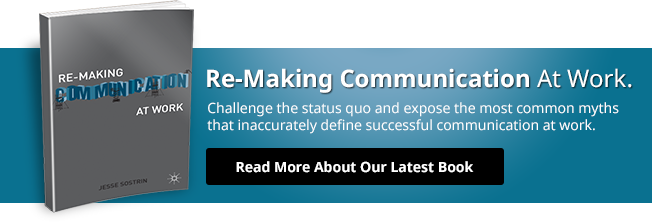Communication Perspective = Competitive Advantage

One of the most significant competitive advantages for organizations in the twenty-first century is a workforce that has the capacity to identify unwanted individual, team, and organizational patterns of communication and interaction and re-make them into something that better aligns with their true values, priorities, and desired performance outcomes. Implementing the concepts and tools of re-making communication at work can accelerate this competitive advantage, which marks a shift from relying on “technical resources” and “people” to a focus on the ways people intentionally develop patterns of communication that create the conditions for achieving the organization’s greatest goals.
This is true because the most inescapable demand of work is the need to communicate with other people. For individual contributors, the quality of the communication they engage in directly reflects their relationships with coworkers, the level of motivation and engagement they feel, the impact and performance they contribute, and the general quality of their working lives. For leaders, the quality of the communication they engage in directly reflects their relationships with their direct reports, the capacity to motivate and engage people, the alignment of team performance with company goals, the capacity to manage complexity and change, and the overall influence of their leadership on vital benchmarks like workforce retention and productivity and ultimately culture.
Re-making communication at work boils down to one simple idea: The experiences and outcomes you get at work are made in the specific patterns of communication and interaction you engage in. If you want something different in your everyday experience at work or in the long-term arc of your career, you have to make that change by altering your fundamental building blocks of communication. If you want to be an effective leader that achieves results, inspires others, and adds lasting value to your organization, you will achieve that impact by creating the patterns of communication that create the conditions for you to deliver these results. Once you fully integrate this concept, exercise the principles, and practice the tools, you re-make communication at work every time you:
1. Take a communication perspective and understand that meetings are not just meetings and conversations are not just conversations. The everyday episodes of interaction that play out in our working lives are governed by rules and they move us closer to or further away from the outcomes and experiences we seek.
2. Recognize your patterns of communication and interaction where decisions get made, relationships are built, organizational culture is solidified, and the trajectory for ultimate business outcomes are set into motion.
3. Examine what you make and select unwanted patterns to re-make. Spot the critical moments where something different/better could be made, understand how to create the flexible conditions for change, follow a sequence of steps to re-make unwanted patterns of communication and interaction, and learn to avoid everyday pitfalls that can undermine these new patterns and the benefits they bring.
4. Gain a significant competitive advantage by re-making communication at work. Perhaps one of the most significant sources of competitive advantage is the capacity to literally re-make unwanted patterns into coordinated efforts that align people with priorities, bring out the best in people’s talent and motivation, and boost learning and performance by closing the inevitable gaps that emerge when things go bad.
If there is a manifesto in all of this, it is: go make the patterns you want to experience. If work is a miserable bore, make something more interesting. If your relationships with colleagues are threatening and void of respectful trust, make something more trustworthy. If you are more or less engaged in your work but feeling a little complacent, make something more challenging. After all, you are already a central figure in the everyday patterns of communication and interaction you live. If you keep your distance, erroneously thinking that you are separate and apart from them, you surrender your leverage for transforming them. If you take ownership of your role and if you focus your attention on the turns that align episodes and the episodes that open patterns, you take back your power for crafting your own working life.

